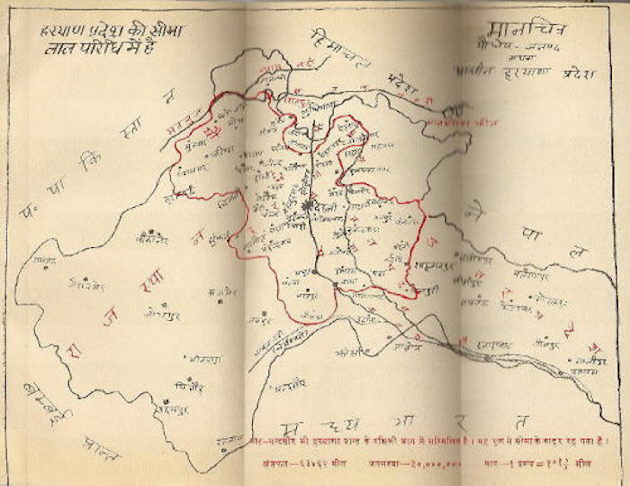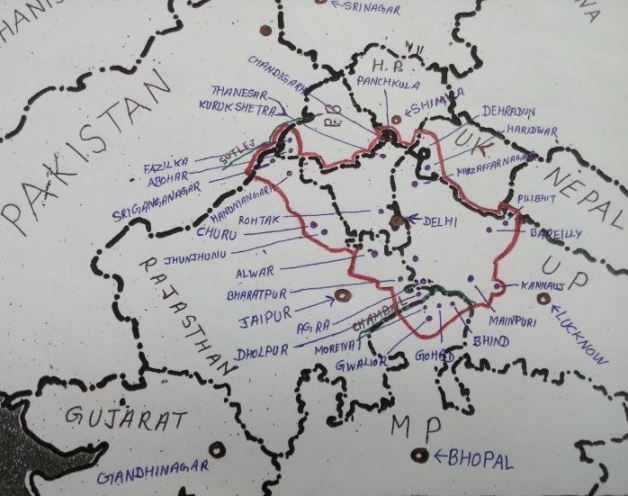Haryana Day is its reformation day, not birthday: This article aims on elaborating what real Haryana has been and 1
st November 1966 is its reformation day instead of formation day or birthday and should be called as such.
Ancient as well as present day Haryanvi speaking area and its annoyance: The struggle of Haryanvies to get their "Haryana Desh" has been very tiring and endless. As of the day Western Haryana in form of present day Haryana only has been brought up in its uniqueity; rest of Haryana i.e. Central (Delhi), Eastern (West U.P. and South-West Uttrakhand), Southern (North Rajsthan) and Western (Fazilka-Abohar) regions are yet to accumulate in it, to get its real shape.
Nothing can be cruel and ridiculous for a state where its own history and culture find minimal mentioning in books of its own state board for education. It has been a province which was kept bifurcated as a punishment to its fierce revolutions and stern calls against time to time found foreign invaders turned rulers.
Stern Action and Participation of "SarvKhap Haryana" led its bifurcation: In 1857' first revolution for Indian independence, the then last emperor of India Bahadurshah Zafar called upon "Sarvkhap Haryana" by sending a calling letter to their HQ at "Historical Sorem Chabutra", Muzaffaranagar, U.P. to take the lead of the revolution, which Khaps took in such a stern velocity under Baba Shahmal Tomar and allies that Britishers got enough iron to assess "SarvKhap Haryana" as the biggest machinery behind it. Thus as a post-consequence of it and to break the power of "SarvKhap Haryana" of the region till date known as "Haryana Desh", it was bifurcated accros banks of Yamuna, making Yamuna river as line of "Aar-Paar". Western U.P. including Uttrakhand was merged into Eastern U.P. sometimes called as Awadh, West Haryana was given to Punjab, Dilli was kept as independent unit and under their direct charge, sourthern parts were gifted to Rajsthan. This fragmentation was so severe that people were even banned to marry across Yamuna River.
As a fact not to forget in mentioning that the roots of this bifurcation watered back in 1803, with entry of several farmers and peasantry agitations led by local farming revolutionists in regions across Gohad, Rohtak and Agra in pre-independence history of India.
Post India Independence politics make it a hanging dream: In 1955, newly formed government of independent India formed a commission for the reorganization of her states, internal territories and provinces on the besis of language, culture, life-style and historical affinity. People of Haryana had submitted demand before this commission in 1955-56 demanding carving out of
Haryana comprising of its historically bifurcated Hindi speaking areas of the then Punjab, Western Uttar Pradesh, Delhi and districts of Jhunjhunu, Bharatpur, Sriganganagar, Alwar and Dheeg in Rajasthan on the basis of cultural, linguistical (Haryanvi dialectical accent) and historical affinity (like Bharatpur riyasat was spread across borders of modern day Rohtak, Jhajjar, Gurgaon and Faridabad). But the then central government rejected their plea on the basis of keeping the border state of India Punjab as a strong unit of the Union of India, keeping the stronghold of U.P. in central politics and the fertile area
of western U.P. {eastern part of bowl of grains (full bowl comprises of Punjab, Haryana and Western U.P.)} which otherwise had put an adverse effect on economy of U.P. as a whole.
However it led to dissatisfaction among the Haryanavies and friction continued till 1966 when Haryana was carved out on the basis of linguistic reorganization of the then Punjab on 1st November, 1966. The Pahadi languages spoken areas of the then Punjab were merged with Himachal Pradesh and a new Union Territory namely Chandigarh also came into existence. Even in 1966, the then 1955' demanded Haryana reorgnaization was not fulfilled and the rest of region is still going bifurcated.
Haryana will be a complete state in true sense when these regions of Western U.P., Dilli, districts of northern Rajsthan, some more Hindi (Haryanvi) speaking regions left with Punjab alongwith modern day Haryana would be merged as one state. Below map shows how it will look alike if this so long awaited demand of people is met. But now it seems in the deep interest of current ambitious domestic politics to carry on the flay.
 Image:
Image: Borders of Ancient Haryana Province in red lines
 Image:
Image: Borders of Ancient Haryana Province in red lines as per Haryanvi Researcher Parveen Nain.
The Palam Boali Inscription which deals with period of 12th century, which contains its name as Haryana Desh.
But Haryana as a country is recorded much before by Jain poet Vibudh Sridhar in his book Pasanah Chariu. Here he mentions about Haryana Desh, its capital and charcter of its people,
"There are countless villages in
Haryana country. The villagers there work hard. They
don't accept domination of others, and are experts in making the blood of their enemies flow. God Indra himself praises this country. The
capital of this country is Dilli. So this book clearly found Dilli as capital of Haryana of ancient times.
The word Haryana, in fact, signified a land which abounded in greenery and vegetation. Its other name Bahudhanyaka which occurs in the mythology of Mahabharata and on the SarvKhap Yaudheya coins conveys the same meaning.
A cursory glance on glory and importance of ancient Haryana: Beside the very well-known and the biggest Indian mythological war of Mahabhart, Haryana has been battle ground of several real time wars. Three battles of Panipat, battles of Tarain 1191-92, battle of Karnal 1739 and rise of farmers and peasants against the British occupation of the region since 1803 onwards, 1857 mutiny fought in flagship of “Sarvkhap Haryana” are the testimony of the existence of this prime land in the forefront of the national politics. Thanesar (now in Kurukshetra) was the seat of power of Khap lover Maharaja Harashvardhan Bains during period of 643 A.D.
Haryanvi is a language not a dialect: Currently Haryanvi falls under Indo Iranian > Indo-Aryan > Central zone > Haryanvi, language family chain. Below is how the family of Haryanvi language can be distributed on geographic map:
- Khaadar: Spoken in the belt of Karnal-Panipat and Sonipat belt.
- Deshwali: Spoken in Rohatak, Jhajjar, southern districts of Jind in Haryana and central-north-western belt of Dilli. The native residents of Dilli are Haryanvi speaking. It is spoken in some parts of Hissar, Bhiwani and Mahandergadh. Deshwali is spoken in Sonipat along with Khaadar.
- Bangru: Spoken in districts of Kaithal, Jind, north-eastern Hissar and eastern Fatehabad.
- Bagdi: Spoken in Sirsa, west-southern Hissar, western Fatehabad, Bhiwani, Mahendragarh belts of Haryana and Jhunjhnu, Sreeganganagar, Churu, Hanumangarh and Rajgarh belt of Rajsthan and Fazilka, Abohar belt of Punjab.
- Khadi Boli: Mainly spoken in belt of Western UP and eastern Dilli and with a mixture of Khaadar in Karnal-Panipat-Kurukshetra-Yamunanagar region.
- Rangdi: Spoken in borderning Pakistan. It is the language of Haryanvi Hindus turned Muslims and later on migrated to Pakistan in 1947.
- Braj Bhasha: Spoken in Faridabad, Agra, Mathura belt of U.P. and Alwar, Dheeg and Bharatpur belt of Rajsthan.
- Kourvi: Spoken in Karnal, Kurukshetra, Panipat, Yamunanagar, Ambala, Meerut, Saharanpur, Kalka and Panchkula.
- Mewati: Spoken in Gurgaon, Rewari and Narnoul.
- Ahirawati: Spoken in regions of Rewari, Mahendergarh and Narnoul, it is shared Mewati Haryanvi. Other than this parts of Tahseels of Jajhjhar, Dadri, Bhiwani of Haryana and Bahrod, Mundavar and baansur of Rajsthan are also counts in Ahirawati.
So in this way we can see that various forms of Haryanvi is spoken on a vast area of India, which comprise of around 10 to 11 crores of Indian population as per recent census held in 2011.
It is just not the language but its cultural values, ethics, social norms also present a unanimous similarity. Haryanvies prefer to tie marriage knots out of same surname, relations of brotherhood and family clans like Tapa, Khaps inhibits till date throughout presence of ages old social democracy of Gantantra, villages are established on the line of “Dada Kheda Civilization”; all together give a rigid strength to call this region still as "Haryana Desh".
Special Note: NH-AB supports the status of
"Rajbhasha" for Haryanvi in Indian Languages. We appreciate all such kind of initiatives and lobbying by our local political leaders like Rohtak M.P. Ch. Deepender Hooda and Kurukshetra M.P. Mr. Naveen Jindal to get Rajbhasha status for Haryanvi in National Parliament.
Conclusion: 1st November, 1966 should be called as re-birth year instead of birth year of Haryana - Today's Haryana is just a part of Haryana pre-1857, part of that Haryana; which constituted the present day Haryana, Delhi, northern Rajsthan and western Uttar Pardesh. So present day Haryana is not the whole Haryana but Delhi, Western U.P. and Northern Rajsthan are still kept separated from it. Existence of Khaps throughout these regions and different dialects of Haryanvi being language of natives of this region further strengthen this fact.
Note: This article is written purely with intention of describing the history of ancient Haryana i.e. Haryana Desh and its geographical expension on the basis of language and culture affinity. So in no way it should seen as any kind of contradiction to current Indian fabric and interests. We also ask you to correct us on any point if found missing the facts. More content will be added to article with time.